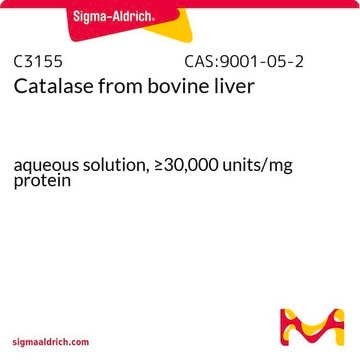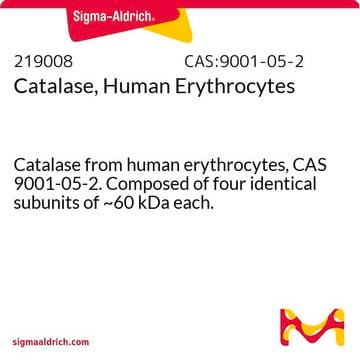Conjugating PEG to catalase is recognized to improve protein stability, leading to an extended circulatory half-life for the enzyme.
C4963
Catalase−polyethylene glycol
lyophilized powder, ~40,000 units/mg protein
Synonym(s):
PEG-Catalase
Select a Size
About This Item
Recommended Products
form
lyophilized powder
Quality Level
specific activity
~40,000 units/mg protein
mol wt
PEG 5,000
composition
Protein, ~50% E405
extent of labeling
~40 mol PEG per mol protein
matrix attachment
secondary amine linkage.
storage temp.
−20°C
Looking for similar products? Visit Product Comparison Guide
Application
Biochem/physiol Actions
Packaging
Other Notes
Physical form
Storage Class Code
11 - Combustible Solids
WGK
WGK 3
Flash Point(F)
Not applicable
Flash Point(C)
Not applicable
Personal Protective Equipment
Choose from one of the most recent versions:
Already Own This Product?
Find documentation for the products that you have recently purchased in the Document Library.
Customers Also Viewed
-
I would like to know the function of PEG with the catalase for this product.
1 answer-
Helpful?
-
-
What is the Department of Transportation shipping information for this product?
1 answer-
Transportation information can be found in Section 14 of the product's (M)SDS.To access the shipping information for this material, use the link on the product detail page for the product.
Helpful?
-
-
What can I use to solubilize Catalase-polyethylene glycol, Product C4963?
1 answer-
It is soluble in water at a concentration of 1 mg/mL.
Helpful?
-
-
What is the solution stability of Catalase-polyethylene glycol, Product C4963?
1 answer-
We generally recommend preparing fresh solutions of Catalase-PEG. If stock solutions must be stored, we recommend first dissolving in water, then diluteing with an equal volume of glycerol. This 50% glycerol solution may be kept in the freezer at -20°C. Aqueous solutions held at 37°C were found to lose approximately half of the catalase activity after about 10 days.
Helpful?
-
-
What is the specific activity of Catalase-polyethylene glycol, Product C4963?
1 answer-
The certificate of analysis on our website will have lot-specific activity information.
Helpful?
-
Active Filters
Our team of scientists has experience in all areas of research including Life Science, Material Science, Chemical Synthesis, Chromatography, Analytical and many others.
Contact Technical Service










